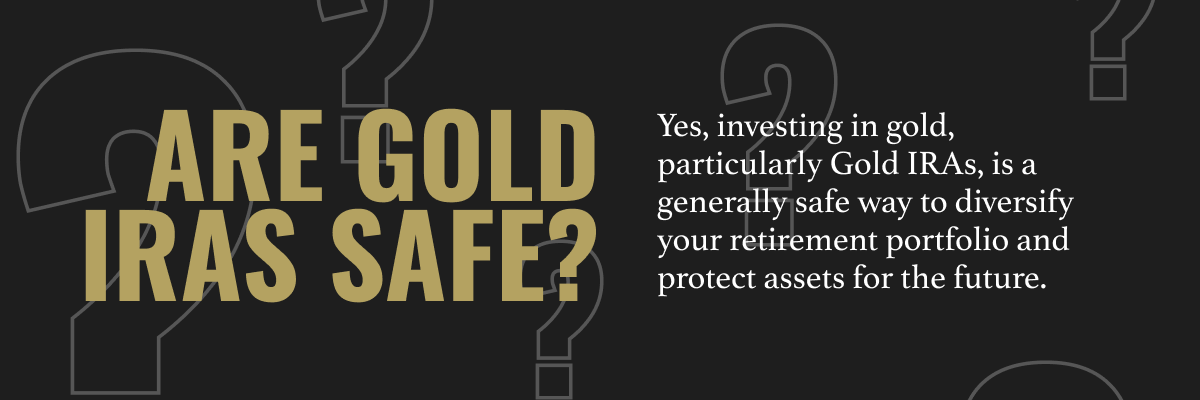Are Gold IRAs Safe? Everything You Need to Know
Investing involves risk, whether in a new product, real estate, stocks, bonds, or even retirement funds. What makes investing less risky, traditionally, is diversifying a portfolio. Instead of putting their eggs in one basket, many insightful investors might allocate their assets across a spectrum to protect against various economic factors.
One of those investment vehicles? Gold.
IRA gold investment is an increasingly popular avenue, especially for those who are close to retirement. One common question, however, is whether Gold IRAs are safe options for retirement accounts.

The answer isn’t as complicated as you’d think: Yes, investing in gold—particularly Gold IRAs—is a generally safe way to diversify your retirement portfolio and protect assets for the future.
A Gold IRA is a self-directed IRA that allows you to purchase gold. In some cases, Gold IRAs might be called precious metal IRAs or Silver IRAs (depending on which precious metals, such as palladium, platinum, and silver, the investor buys). We typically use Gold IRA as a catchall because gold is the most common asset in this portfolio.
But what makes a Gold IRA better than simply buying a sack of gold coins and hiding them under a floorboard? The answer lies in understanding how Gold IRAs work.
Is It Safe to Open a Gold IRA?
Compared with more fad-like investment options (cryptocurrency or NFTs), gold has always been a popular investment asset. More importantly, it has been historically stable over time. Gold is even more attractive for investors during high inflationary periods or uncertain economic headwinds.
What makes gold so popular? It’s a unique commodity with a finite supply, which gives it strategic value. And unlike other investment classes—such as securities—gold’s history goes back thousands of years.
There’s also a significant lack of counterparty risk. All gold bars conform to international standards, which ensures investors know precisely what they’re getting.
Can I Lose My Gold if the Market Crashes?
Most people purchase gold as a hedge against market conditions, including crashes. Over the years, gold prices have tended to increase, even amid the worst stock market crashes.
Why does this happen?
Gold and the stock market typically see an inverse correlation. That means that as stocks benefit and increase in value due to economic growth and stability, gold does not. During economic downturns, however, stocks may fall while the value of gold rises. Remember: Savvy investors seek out gold or precious metals as safe haven investments.
Are Gold IRAs Insured by the FDIC?

Gold IRAs are not eligible for FDIC insurance because they’re an investment product, not a bank deposit.
But that doesn’t mean Gold IRAs are entirely unprotected. While they may not be covered by FDIC insurance, they can be protected in other ways. Gold IRAs require storage in a depository, and many of these locations have their own insurance policies to safeguard against theft or damage. It’s also worth noting that reputable IRA custodians often purchase insurance for fraud or theft.
Before you invest in a Gold IRA, research your preferred custodians’ and depositories’ insurance policies and make sure they meet your needs.
Is Investing in Gold a Safe Way to Diversify?
Because of its resistance to market conditions, investing in gold has been a historically fantastic and safe way to diversify your portfolio. But, like any investment, there are both pros and cons. We’ve listed below some of the most important considerations for any aspiring gold investor.
Advantages of a Gold IRA Investment
Gold IRAs offer several advantages for investors, including:
- Diversification of your portfolio: Gold IRAs allow investors to diversify their portfolio beyond traditional assets like stocks and bonds. This can help to reduce risk, as the value of gold often moves independently from other asset classes.
- Hedge against inflation: Gold is often viewed as a hedge against inflation. When the cost of living increases, the price of gold also tends to rise, helping to preserve the purchasing power of your savings.
- Protection against economic uncertainty: During times of economic uncertainty or instability, gold is often considered a “safe haven” investment. Its value typically remains more stable than paper currencies or other assets.
- Potential for growth: While gold should not be considered a short-term speculative asset, it has shown significant growth over the long term. If you believe the price of gold will increase, a Gold IRA could provide substantial returns.
- Tax benefits: Like other types of IRAs, Gold IRAs offer tax advantages. Depending on whether you choose a traditional or Roth IRA, you can benefit from tax-deductible contributions or tax-free withdrawals.
- Physical asset: Unlike stocks and bonds, gold is a tangible asset that you can hold in your hand. For some investors, there’s an added sense of security in knowing they own a physical commodity.
However, it’s important to note that Gold IRAs also come with risks and costs, such as storage fees and the potential for loss if the price of gold decreases. As with any investment, it’s crucial to research and consider your financial goals and risk tolerance before investing in a Gold IRA.
Risks of a Gold IRA Investment
Investing in any IRA, even a Gold IRA, carries some risk. Be cognizant of the following risks before your purchase:
- Price fluctuation: Even with its relative stability, gold is subject to market forces, and its price can fluctuate over time. Although dramatic price drops are rare, the value of a Gold IRA can go up or down depending on the current price of gold.
- Higher maintenance Fees: Unlike traditional IRAs, Gold IRAs often incur higher maintenance fees. This is due to costs associated with storing and insuring physical gold.
- Early withdrawal penalties: As with other types of IRAs, early withdrawals from a Gold IRA before age 59½ may incur penalties and taxes.
- Contribution limits: The IRS limits how much you can contribute to all your IRAs each year. In 2023, the limit is $6,500, or $7,500 if you’re 50 or older.
- Limited liquidity: Selling gold for cash can take longer than selling stocks or bonds. This could be a disadvantage if you need to access your money quickly.
- Regulatory risk: Certain regulatory changes could impact the value of gold. For instance, central bank or monetary policy changes can affect gold prices.
Even with these risks, gold might still have a place in your portfolio. If you have any concerns, speak to a trusted financial advisor to determine if they’re deal-breakers for your investment plans.
Are Gold IRAs a Safe Investment?
Changing your investment strategy is always a big decision, whether you’re just starting or seeking a way to increase your portfolio’s diversity. Part of that process involves assessing risk, and opening a Gold IRA is no exception. That said, gold’s stability and performance compared with other parts of the economy make it an attractive option.
If you have questions about gold ownership—especially as part of an IRA—we can help answer them. To learn more about converting your retirement assets, including your 401(k), to a Gold IRA, download our guide to Gold IRA rollovers today.
Tags: gold iras safe, how safe are gold iras


